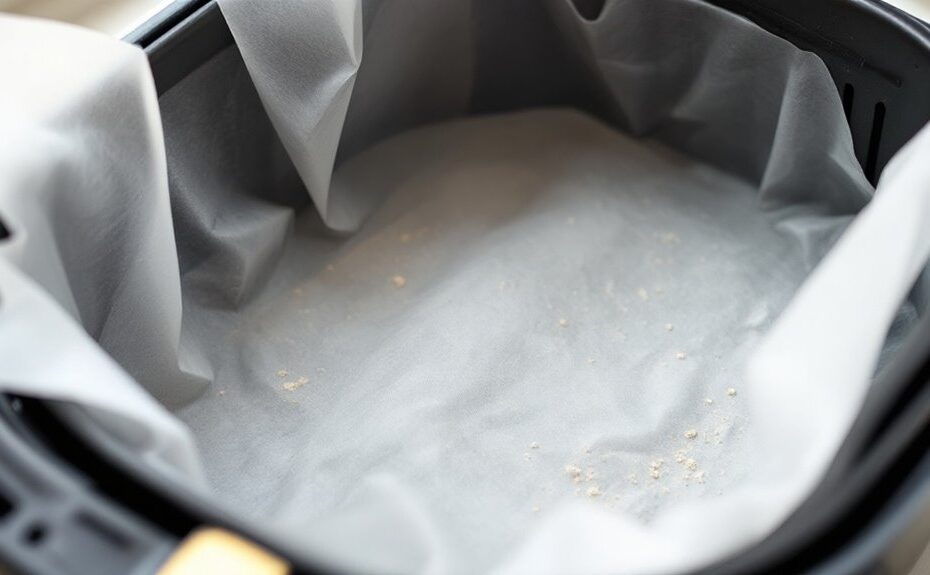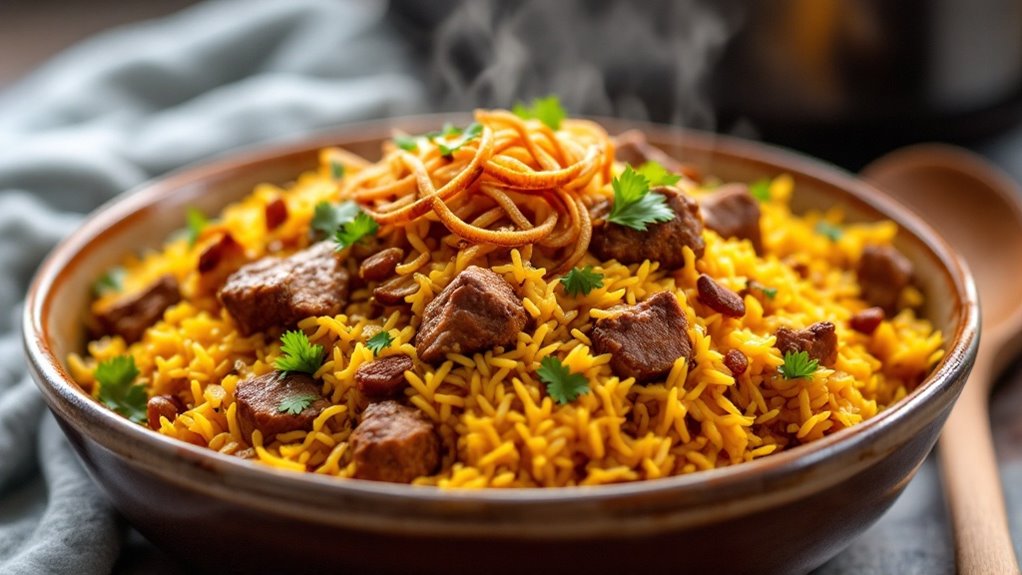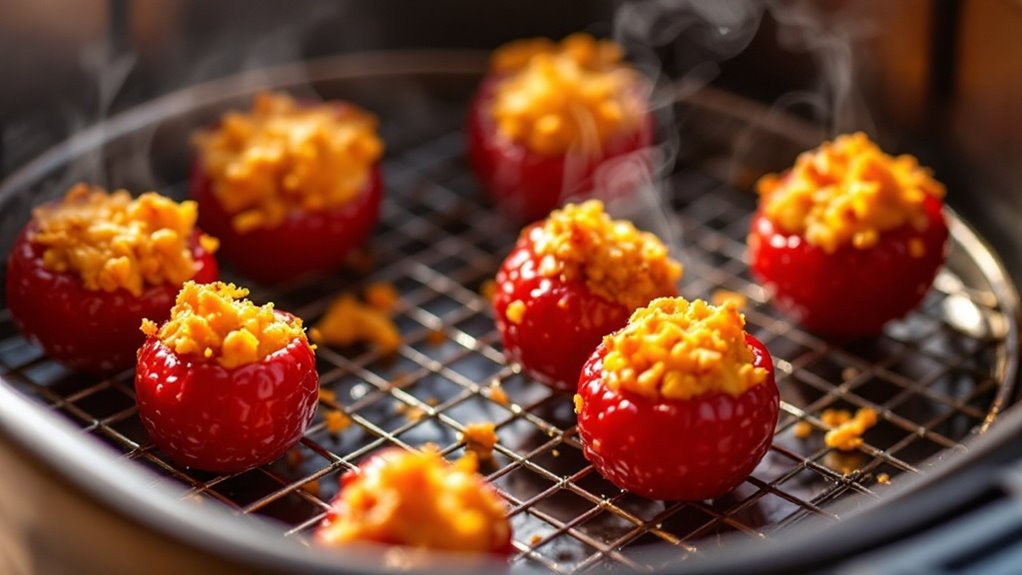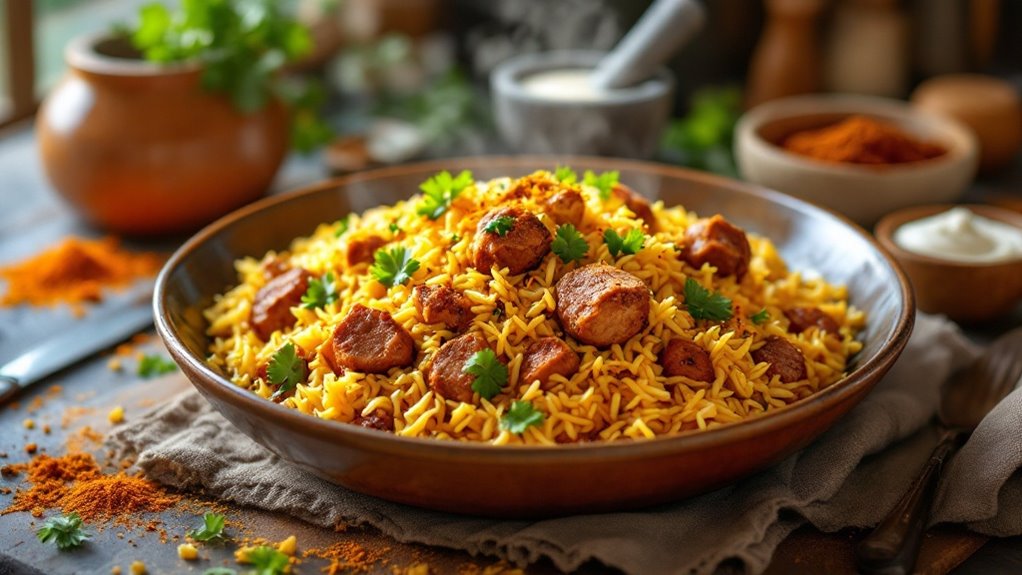You might not realize that parchment paper can be a game-changer for your air fryer, but using it incorrectly could lead to safety hazards. While it's great for preventing mess and sticking, you'll need to make sure it's cut to the right size and placed properly to avoid blocking airflow or touching the heating element. But what happens if you don't follow these steps, and are there better alternatives? Understanding the nuances of using parchment paper in an air fryer could save you time and keep your appliance in top shape—so let's explore how to do it right.
Key Takeaways
- Yes, parchment paper can be used in air fryers to prevent sticking and simplify cleanup, but it must be trimmed to fit the basket.
- Ensure parchment paper doesn't block airflow or touch heating elements to avoid safety risks and maintain proper cooking performance.
- Use heat-resistant parchment paper rated for high temperatures (up to 400°F) to prevent burning or melting during air frying.
- Avoid reusing parchment paper exposed to oils or fats, as it can lower its ignition point and pose a fire hazard.
- Alternatives like silicone mats or lightly greasing the basket can also prevent sticking if parchment paper isn't available.
Benefits of Using Parchment Paper
Using parchment paper in an air fryer can make cleanup easier and prevent food from sticking to the basket. Its non-stick convenience guarantees easy food release, reducing the need for excessive oil or cooking sprays. This can be particularly helpful when preparing delicate items like fish or baked goods, which might otherwise tear or crumble. Parchment paper also minimizes direct contact between food and the air fryer basket, helping to maintain its condition over time. However, you should confirm proper airflow by trimming the paper to fit the basket and avoiding overhangs that could block vents. While parchment paper offers practical benefits, it's crucial to use it correctly to avoid potential safety risks, such as overheating or fire hazards. Always follow manufacturer guidelines for the best results.
Choosing the Right Parchment Paper
When selecting parchment paper for your air fryer, opt for products specifically labeled as heat-resistant and safe for high temperatures. Air fryers typically operate between 300°F and 400°F, so guarantee the paper's heat resistance exceeds this range to prevent burning or melting. Look for a paper thickness that balances durability and airflow; overly thick paper may hinder cooking efficiency, while thin paper risks tearing. Avoid wax-coated or non-silicone-treated options, as they lack the necessary heat resistance. Check for certifications like FDA approval for food safety. Always verify the manufacturer's guidelines to confirm compatibility with air fryers. Choosing the right parchment paper guarantees safe, effective cooking without compromising your appliance's performance or your food's quality.
Proper Placement in the Air Fryer
To guarantee even cooking and prevent airflow obstruction, you'll want to place the parchment paper correctly in your air fryer basket. Start by trimming the paper to fit the basket, making sure it doesn't cover the entire base. Leave at least an inch of space around the edges to maintain proper airflow. For the best basket alignment, press the parchment paper gently into the basket, allowing it to conform to the shape without folding over the sides. Avoid letting the paper touch the heating element or fan, as this could pose a safety risk. These placement tips make certain efficient cooking while minimizing the risk of the paper lifting or blocking air circulation. Proper alignment is key to achieving consistent results and protecting your air fryer's functionality.
Avoiding Overcrowding the Basket
Although air fryers are designed to cook food quickly, overcrowding the basket can disrupt airflow and lead to unevenly cooked meals. To guarantee even cooking, follow basket spacing tips by leaving enough room between food items. Arrange items in a single layer, avoiding stacking, to allow hot air to circulate effectively. Use food arrangement strategies like spacing out larger pieces and placing smaller items around the edges. If you're cooking multiple batches, resist the urge to overfill the basket—this can reduce crispiness and extend cooking times. Proper spacing not only improves texture but also prevents undercooked or burnt spots. By prioritizing airflow, you'll achieve consistent results and maximize your air fryer's efficiency. Always monitor your food and adjust placement as needed during cooking.
Pre-Cutting Parchment Paper for Safety
Pre-cutting parchment paper to fit your air fryer basket guarantees it doesn't interfere with airflow or pose a fire risk. Measure the basket's dimensions and trim the paper slightly smaller to avoid overhanging edges, which can contact heating elements. Proper sizing reduces hazards and maintains even cooking performance.
Proper Sizing Techniques
When using parchment paper in an air fryer, it's essential to pre-cut it to fit the basket properly to avoid safety hazards. Start by measuring the basket's diameter and depth to guarantee the paper thickness and size measurement align with the air fryer's specifications. Use a ruler or template to cut the parchment paper slightly smaller than the basket's base, leaving a small gap around the edges. Avoid cutting it too large, as excess paper can obstruct airflow or come into contact with heating elements. Opt for parchment paper with a standard thickness (around 0.3 mm) to prevent tearing or burning. Always double-check the fit before placing food on the paper to maintain safe and efficient cooking conditions.
Avoiding Overhang Hazards
Overhanging parchment paper in an air fryer can pose significant risks, such as blocking airflow or catching fire if it touches the heating elements. To guarantee air fryer safety, always pre-cut the parchment paper to fit the basket or tray without extending beyond the edges. Use scissors or a ruler to measure and trim the paper precisely, leaving no excess. This simple step is one of the most effective fire prevention tips, as it minimizes the chance of the paper curling up or coming into contact with the heating mechanism. Avoid folding or layering the paper, as this can also disrupt airflow. By taking these precautions, you'll reduce hazards and maintain ideal cooking conditions while using parchment paper in your air fryer.
Monitoring Airflow and Heat Distribution
To guarantee even cooking and prevent hot spots, it's important to monitor airflow and heat distribution when using parchment paper in an air fryer. Parchment paper can slightly reduce airflow efficiency, so make sure it doesn't block the fryer's vents or fan. Cut the paper to fit the basket without covering the entire base, leaving gaps for proper air circulation. Heat consistency is critical; uneven airflow may cause some areas to cook faster than others. Check food periodically and rotate it if necessary to promote uniform cooking. Avoid overcrowding the basket, as this can further disrupt airflow. While parchment paper is heat-resistant, excessive blockage of airflow may lead to inconsistent results. Always prioritize maintaining the fryer's designed airflow patterns for peak performance.
Preventing Parchment Paper From Flying
Since parchment paper is lightweight, it can lift or fly inside the air fryer due to the powerful airflow. To prevent this, focus on securing edges and proper weight placement. Start by trimming the parchment paper to fit the basket, leaving a small overhang to tuck under the edges. This helps anchor it in place. Alternatively, you can use small, heat-safe weights like metal clips or food items (e.g., potatoes or onions) to hold the paper down. Avoid covering the entire basket, as this restricts airflow and increases the risk of lifting. Always make sure the parchment paper doesn't block the air fryer's heating element or fan. By taking these precautions, you'll minimize movement and maintain safe, even cooking.
Reusing Parchment Paper in the Air Fryer
Reusing parchment paper in an air fryer requires careful consideration of safety and durability. You should inspect the paper for signs of scorching, grease saturation, or tears, as these can compromise its integrity and safety. While some papers may withstand multiple uses, their longevity depends on the cooking temperature and food type, so err on the side of caution to avoid potential hazards.
Safety Considerations
While parchment paper is generally safe for air fryer use, reusing it poses potential risks. Repeated exposure to high heat can weaken the paper, increasing fire risks if it tears or comes into contact with heating elements. Additionally, reused parchment may accumulate food residues, which can burn and release harmful fumes, raising concerns about chemical exposure. Always inspect the paper for signs of wear, such as discoloration or brittleness, before reuse. Avoid reusing parchment that has been exposed to oils or fats, as these can lower its ignition point. For safety, prioritize single-use applications and dispose of parchment after each cooking session. Following these precautions minimizes hazards and guarantees your air fryer remains a safe cooking tool.
Longevity and Durability
Parchment paper's durability in an air fryer depends on factors like heat exposure, cooking time, and the type of food being prepared. Its heat resistance and material thickness determine how well it withstands repeated use. High-quality parchment paper with a silicone coating can handle temperatures up to 450°F, but prolonged exposure to intense heat may weaken it. Avoid reusing parchment paper if it shows signs of browning, tearing, or brittleness, as these indicate reduced durability. Thicker parchment paper tends to last longer, but even then, it's best to replace it after a few uses to prevent potential hazards. Always inspect the paper before reuse, ensuring it remains intact and free from grease buildup, which can compromise its performance and safety.
Alternatives to Parchment Paper
If you don't have parchment paper on hand, there are several alternatives you can use in your air fryer to prevent food from sticking. Wax paper is one option, but you must use it cautiously. Unlike parchment paper, wax paper isn't heat-resistant and can melt or smoke at high temperatures, so it's best for low-heat cooking. Silicone mats are a safer, reusable alternative. They're heat-resistant, non-stick, and designed to withstand air fryer temperatures. However, make sure the mat fits your air fryer basket without blocking airflow. You can also lightly grease the basket with oil or use aluminum foil, though foil may reduce crispiness. Always monitor your food to avoid burning or uneven cooking when using these substitutes. Choose the option that best suits your recipe and air fryer model.
Cleaning Up After Using Parchment Paper
After using parchment paper in your air fryer, cleaning up is typically straightforward since the paper helps minimize mess. Carefully remove the parchment paper, making sure no food particles or grease remain in the basket. If residue sticks to the basket, use gentle cleaning techniques like wiping with a damp cloth or sponge. Avoid abrasive scrubbers to prevent scratching the nonstick surface. For stubborn residue removal, mix warm water with a small amount of dish soap and let it sit briefly before wiping. Always dry the basket thoroughly to prevent moisture buildup. Regularly inspect the air fryer for any lingering debris, as accumulated grease can affect performance. Proper maintenance guarantees your air fryer stays in good condition and extends its lifespan.
Disclosure: As an Amazon Associate, I earn from qualifying purchases.



